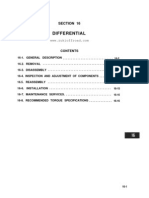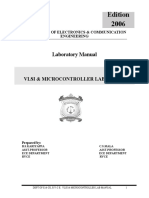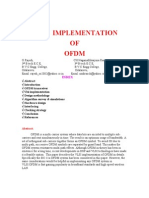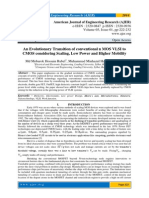0 ratings0% found this document useful (0 votes)
586 viewsSeminar On Cmos
Seminar On Cmos
Uploaded by
Roberto HoodThis document discusses challenges for future development of CMOS technology. It begins by providing background on CMOS technology, noting that transistors today are 20 times faster and occupy less than 1% of the area compared to 20 years ago. However, continued shrinking of transistor size cannot be sustained indefinitely.
The document then examines three key scaling limits for CMOS technology. First, as transistors get smaller, subthreshold leakage increases which raises power consumption. Second, integrating more transistors onto chips leads to higher power usage and heat production. Third, thinning the gate dielectric to enable scaling increases the risk of gate dielectric tunneling, which degrades transistor performance. Overall, the document outlines physical barriers that may impede continued Moore's Law-like scaling
Copyright:
© All Rights Reserved
Available Formats
Download as PDF, TXT or read online from Scribd
Seminar On Cmos
Seminar On Cmos
Uploaded by
Roberto Hood0 ratings0% found this document useful (0 votes)
586 views8 pagesThis document discusses challenges for future development of CMOS technology. It begins by providing background on CMOS technology, noting that transistors today are 20 times faster and occupy less than 1% of the area compared to 20 years ago. However, continued shrinking of transistor size cannot be sustained indefinitely.
The document then examines three key scaling limits for CMOS technology. First, as transistors get smaller, subthreshold leakage increases which raises power consumption. Second, integrating more transistors onto chips leads to higher power usage and heat production. Third, thinning the gate dielectric to enable scaling increases the risk of gate dielectric tunneling, which degrades transistor performance. Overall, the document outlines physical barriers that may impede continued Moore's Law-like scaling
Original Title
Seminar on cmos
Copyright
© © All Rights Reserved
Available Formats
PDF, TXT or read online from Scribd
Share this document
Did you find this document useful?
Is this content inappropriate?
This document discusses challenges for future development of CMOS technology. It begins by providing background on CMOS technology, noting that transistors today are 20 times faster and occupy less than 1% of the area compared to 20 years ago. However, continued shrinking of transistor size cannot be sustained indefinitely.
The document then examines three key scaling limits for CMOS technology. First, as transistors get smaller, subthreshold leakage increases which raises power consumption. Second, integrating more transistors onto chips leads to higher power usage and heat production. Third, thinning the gate dielectric to enable scaling increases the risk of gate dielectric tunneling, which degrades transistor performance. Overall, the document outlines physical barriers that may impede continued Moore's Law-like scaling
Copyright:
© All Rights Reserved
Available Formats
Download as PDF, TXT or read online from Scribd
Download as pdf or txt
0 ratings0% found this document useful (0 votes)
586 views8 pagesSeminar On Cmos
Seminar On Cmos
Uploaded by
Roberto HoodThis document discusses challenges for future development of CMOS technology. It begins by providing background on CMOS technology, noting that transistors today are 20 times faster and occupy less than 1% of the area compared to 20 years ago. However, continued shrinking of transistor size cannot be sustained indefinitely.
The document then examines three key scaling limits for CMOS technology. First, as transistors get smaller, subthreshold leakage increases which raises power consumption. Second, integrating more transistors onto chips leads to higher power usage and heat production. Third, thinning the gate dielectric to enable scaling increases the risk of gate dielectric tunneling, which degrades transistor performance. Overall, the document outlines physical barriers that may impede continued Moore's Law-like scaling
Copyright:
© All Rights Reserved
Available Formats
Download as PDF, TXT or read online from Scribd
Download as pdf or txt
You are on page 1of 8
B. SVILII, A.
KRA: CMOS technology: chalanges for future development
Pomorstvo, god. 20, br. 2 (2006), str. 97-104 97
Boris Svilii, M.Sc. Preliminary Communication
Antun Kra, Ph.D. UDK: 621.3.049.77
Faculty of Maritime Studies Rijeka 621.382.3
Studentska 2 Received: 4
th
October 2006
51000 Rijeka Accepted: 9
th
October 2006
CMOS TECHNOLOGY: CHALANGES FOR FUTURE
DEVELOPMENT
Since the invention of the integrated circuit technologies, there has been an
unprecedented growth of the electronic industry, with significant impact on the
maritime industry. In the last twenty years and so, the strongest growth area of the
electronic industry has been in CMOS VLSI technology. The sustained growth in
CMOS VLSI technology is fueled by a continued shrinking of transistors to ever
smaller dimensions. The benefits of miniaturization are higher packing densities,
higher circuit speeds, and lower power dissipation. The transistors manufactured
today are 20 time faster and occupy less than 1% of the area of those built 20 years
ago. It is obvious that a continued reduction of the transistor area cannot sustain
forever. This paper examines issues related to the future development of CMOS
technology.
Key words: CMOS, MOSFET, VLSI, integrated circuit, scaling
1. INTRODUCTION
The remarkable characteristic of transistors that fuels the rapid growth of
the electronic technology industry is that their speed increases and their cost
decreases as their size is reduced. The transistors manufactured today are 20
times faster and occupy less than 1% of the area of those built 20 years ago [7].
It seems intuitively obvious that a continued reduction of the area of a transis-
tor by a factor of 2 every three years cannot be sustained forever.
CMOS circuits were invented in 1963 by Frank Wanlass. Some twenty-five
years later, CMOS technology has become the predominant technology in dig-
ital integrated circuits. This is essentially because area occupation, operating
speed, energy efficiency and manufacturing costs have benefited and continue
to benefit from the geometric downsizing that comes with every new genera-
tion of semiconductor manufacturing processes.
Pomorstvo_2006_2.indb 97 7.12.2006 11:05:55
B. SVILII, A. KRA: CMOS technology: chalanges for future development
98 Pomorstvo, god. 20, br. 2 (2006), str. 97-104
2. CMOS TECHNOLOGY
Complementary-symmetry/metal-oxide-semiconductor (CMOS) is a major
class of integrated circuits. CMOS chips include microprocessor, microcon-
troller, static RAM, and other digital logic circuits. The words complementa-
ry-symmetry refers to the fact that the design uses symmetrical pairs of p-type
and n-type MOSFET transistors for logic functions, only one of which is
switched on at any time (Figure 1.) [1].
Figure 1. CMOS Inverter
The phrase metal-oxide-semiconductor is a reference to the nature of
the fabrication process originally used to build CMOS chips (Figure 2) [3].
That process created field effect transistors having a metal gate electrode
placed on top of an oxide insulator, which in turn is on top of a semiconductor
material. Instead of metal, today the gate electrodes are almost always made
from a different material, polysilicon, but the name CMOS nevertheless con-
tinues to be used for the modern descendants of the original process.
The performance of CMOS VLSI chip is measured by its integration den-
sity, switching speed, and power dissipation. CMOS circuits have the unique
characteristic of practically zero standby power, which enables higher integra-
Figure 2. CMOS Inverter - schematic device cross section.
Pomorstvo_2006_2.indb 98 7.12.2006 11:05:56
B. SVILII, A. KRA: CMOS technology: chalanges for future development
Pomorstvo, god. 20, br. 2 (2006), str. 97-104 99
tion levels. The other important characteristic of CMOS devices is high noise
immunity. Typical commercial CMOS products are integrated circuits com-
posed of millions (or hundreds of millions) of transistors of both types on a
rectangular piece of silicon of between 0.1 and 4 square centimeters.
3. MOSFET SCALING
The steady downscaling of MOSFET devices dimensions over the past two
decades has been the main stimulus to the growth of CMOS integrated circuits.
Scaled MOSFETs are desirable for a few main reasons. Scaled MOSFETs al-
low more current to pass. Conceptually, MOSFETs are like resistors in the
on-state, and shorter resistors have less resistance. Furthermore, since scaled
MOSFETs have lower gate capacitance, and since the amount of charge on a
gate is proportional to its capacitance, logic gates incorporating scaled MOS-
FETs have less charge to move. Indeed, these two factors combined contribute
to lower switching times, and thus higher operating speeds.
Another important reason for MOSFET scaling is a reduced area, leading
to a reduced cost. Scaled MOSFETs can be packed more densely, resulting in
either smaller chips or chips with more computing power in the same area.
Since the cost of fabricating a semiconductor wafer is relatively fixed, the cost
of producing integrated circuits is mainly related to the number of chips that
can be produced per wafer. Hence, smaller integrated circuits allow more chips
per wafer, reducing the price per chip.
The basic principle of MOSFET scaling lies in scaling the device voltages
and device dimension (both horizontal and vertical) by the same factor so that
the electric field remains unchanged (Figure 3) [1]. This assures that reliability
of the scaled device is not worse than that of the original device.
Figure 4 shows the scaling trend of a power-supply voltage (V
dd
), threshold
voltage (V
t
), and gate-oxide thickness (t
ox
) as a function of CMOS channel.
Figure 3. Principles of MOSFET constant electric field scaling.
Pomorstvo_2006_2.indb 99 7.12.2006 11:05:56
B. SVILII, A. KRA: CMOS technology: chalanges for future development
100 Pomorstvo, god. 20, br. 2 (2006), str. 97-104
4. SCALING LIMITS
Producing MOSFETs with source-to-drain spacing i.e. channel length (Fig-
ure 3, value L) smaller than micrometer is a challenge, and the difficulties of
semiconductor device fabrication are always a limiting factor in advancing in-
tegrated circuit technology. Recently, MOSFET scaling was propelled by the
rapid advancement of high-resolution lithographic techniques and ion implan-
tation techniques [2], and the small size of the MOSFET has created opera-
tional problems.
4.1. Subthreshold leakage
Because of small MOSFET geometries, the voltages that can be applied to
the gate must be reduced as well to maintain reliability. As threshold voltage is
reduced as well, the transistor cannot be completely turned off. The transistor
operates in a weak-inversion mode, with a subthreshold leakage between source
and drain.
The standby power of a CMOS chip due to source-to-drain subthreshold
leakage is given by
Figure 4. History and trends of a power-supply voltage (V
dd
), threshold voltage (V
t
),
and gate-oxide thickness (t
ox
) vs. channel length for CMOS logic technologies.
Pomorstvo_2006_2.indb 100 7.12.2006 11:05:57
B. SVILII, A. KRA: CMOS technology: chalanges for future development
Pomorstvo, god. 20, br. 2 (2006), str. 97-104 101
where W
tot
is the total turned-off device width with V
dd
across the source
and drain, I
off
is the average off-current per device, I
0
is the extrapolated cur-
rent per width at threshold voltage, m is a dimensionless ideality factor, and V
t
is the threshold voltage. The off-state leakage current would increase by about
ten times for every 0.1 V reduction of V
t
. For a chip with an integration level of
100 million transistors, the average leakage current of turned-off devices should
not exceed a few times 10
-8
A. This constraint holds the threshold voltage to a
minimum of about ~0.2 V at the operating temperature (100C worst case).
4.2. Heat production
As more transistors are integrated on a chip to enable more functions and
a higher frequency is used to obtain an increased performance, the total power
consumption increases and results in more heat. The active power of a CMOS
chip (crossover currents are usually negligible), is given by
where C
tot
is the total node capacitance being charged and discharged in a
clock cycle, and f is the clock frequency. As CMOS technology advances, clock
frequency goes up. The total switching capacitance is likely to increase as well,
as one tries to integrate more circuits into the same or an even larger chip area.
The active power of todays high-end microprocessors is already in the 50 - 100
W range.
Integrated circuits operate slower at high temperatures, and have reduced
reliability and shorter lifetimes. Heat sinks and other cooling methods are now
required for many integrated circuits including microprocessors.
4.3. Gate dielectric tunneling
The gate electrode turns the transistor on and off, and a gate dielectric is
an insulator beneath it (Figure 3, value t
OX
). The voltage of the gate electrode
above it controls the flow of electric current across the transistor. The gate di-
electric should be made as thin as possible to increase the channel conductivity
and to keep short-channel effects under control when a transistor is on, and to
reduce subtreshold leakage when a transistor is off. To keep the electric field
constant during the MOSFET scaling, the gate dielectric thickness should be
shrink proportional to the scaling factor:
Pomorstvo_2006_2.indb 101 7.12.2006 11:05:58
B. SVILII, A. KRA: CMOS technology: chalanges for future development
102 Pomorstvo, god. 20, br. 2 (2006), str. 97-104
where F
OX
is the standard MOSFET electric field, V
GS
is the standard MOS-
FET gate voltage, and t
OX
is the standard MOSFET gate dielectric thickness.
F
OX
, V
GS
, , and t
OX
are the electric field, gate voltage, and gate dielectric thick-
ness for the scaled MOSFET device.
The gate dielectric (currently made of silicon dioxide) thickness of todays
high-end microprocessors in a 65 nm transistor is 1.2 nm, which represents a
thickness of only five atomic layers [6]. While it is amazing that a silicon dioxide
(SiO
2
) can carry us this far without being limited by extrinsic factors such as
defect density, surface roughness, or large-scale thickness and uniformity con-
trol, oxide films, this thin are subject to a quantum-mechanical tunneling, giv-
ing rise to a gate leakage current that increases exponentially as the oxide
thickness is scaled down [4]. These tunneling currents can initiate damage,
leading to previously unexpected reliability concerns in very thin gate dielec-
trics. New device structures or a new gate oxide with a higher dielectric con-
stant will have to be developed to enhance performance without further reduc-
tion of the gate-oxide thickness. No scaling theory exists to guide either
development. In this sense, we will indeed soon reach the limits of CMOS scal-
ing.
4.4. Wiring and interconnections
The wiring required to interconnect transistors must scale at the same rate
as the transistors in order to take advantage of the improvements in size and
speed [5]. The traditionally switching time was roughly proportional to the gate
capacitance of gates. However, with transistors becoming smaller and more
transistors being placed on the chip, the capacitance of the wires connecting
different parts of the chip is becoming a large percentage of capacitance. Re-
ducing the wiring resistance and the inter-layer film capacitance is crucial to
propagating the high-speed pulses generated in a CMOS device with little de-
lay and waveform distortion.
As the dimensions of the interconnect structures continue to shrink, alu-
minium-based inter-connects are being replaced by lower-resistance copper
metallurgy, which can decrease both the wiring resistance and the capacitance.
A research is also underway to move from the CVD oxide/nitride interlayer
dielectrics between wiring levels to various low-dielectric-constant insulators,
which can further decrease the wiring capacitance. Despite these major chang-
es in materials, there is a concern that owing to higher resistivity and capaci-
tance, the extremely small wires will be unable to support performance en-
hancements.
Pomorstvo_2006_2.indb 102 7.12.2006 11:05:58
B. SVILII, A. KRA: CMOS technology: chalanges for future development
Pomorstvo, god. 20, br. 2 (2006), str. 97-104 103
5. CONCLUSION
Conventional CMOS fabrication processes have supported many genera-
tions of shrinking, with each new generation bringing predictable advantages in
terms of cost, speed and power consumption. However, they are rapidly ap-
proaching a brick wall where cost of further progress will outweigh the benefits.
Semiconductor manufactures have been investigating alternative transistor ar-
chitectures such as DG (double-gated) MOSFETS, SOI (Silicon on Insulator)
technology, and Tri-gate technology, but a major problem is the manufactur-
ability of these processes. The CMOS technology will soon have a lower rate of
performance increase as their size is reduced.
At present, it does not appear that there is a viable contender to displace
the CMOS technology. No alternative logic technology is evolving within cost/
performance products on the market today to threaten the CMOS dominance.
And in light of the continuing CMOS performance evolution, an even steeper
evolution and learning curve would be necessary to displace CMOS. There will
likely be variations on CMOS circuits, but no radical shift in circuit type seems
to be on the horizon.
BIBLIOGRAPHY
1. Biljanovi, P., Poluvodiki elektroniki elementi, kolska knjiga Zagreb, 1996.
2. Chang, C. Y., S. M. Sze, ULSI technology, New York, McGraw-Hill, 1996.
3. Taur, Y., T. H. Ning, Fundamentals of Modern VLSI Devices, Cambridge, Cam-
bridge University Press, 1998.
4. Taur, Y., /et al./, CMOS Scaling into the Nanometer Regime, Proc. IEEE 85, 1997.,
486504.
5. Theis, T. N., The Future of Interconnection Technology, IBM J. Res. Develop. 44
(2000), 3, 379390.
6. http://www.intel.com/technology/silicon.
7. http://www.intel.com/research.
Pomorstvo_2006_2.indb 103 7.12.2006 11:05:58
B. SVILII, A. KRA: CMOS technology: chalanges for future development
104 Pomorstvo, god. 20, br. 2 (2006), str. 97-104
Saetak
CMOS TEHNOLOGIJA: IZAZOVI ZA RAZVOJ U BUDUNOSTI
Od pojave tehnologije integriranog sklopa, elektronika industrija biljei
nezapamen razvoj, vrei snaan utjecaj na pomorstvo. Posljednjih dvadesetak
godina razvoj elektronike industrije zasnovan je na CMOS VLSI tehnologiji.
Neprekidni napredak CMOS VLSI tehnologije omoguen je kontinuiranim sman-
jivanjem dimenzija MOS tranzistora.
Rezultat skaliranja je vea gustoa pakiranja komponenata po elektronikom
sklopu, vea brzina rada i manja disipacija snage po tranzistoru. Dananji su
tranzistori 20 puta bri te zauzimaju 1% prostora u odnosu na tranzistore proizve-
dene prije 20 godina. Oito je da smanjivanje povrine tranzistora ne moe ii u
beskonanost. Ovim radom se istrauju potencijalna ogranienja razvoja CMOS
tehnologije.
Kljune rijei: CMOS, MOSFET, VLSI, integrirani sklop, skaliranje
Pomorski fakultet u Rijeci
Studentska 2
51000 Rijeka
Pomorstvo_2006_2.indb 104 7.12.2006 11:05:58
You might also like
- 1986-1988 SuzukiSamurai Differential ManualDocument16 pages1986-1988 SuzukiSamurai Differential Manualpuiu_tNo ratings yet
- Experiment No. 3: Layout Design of A CMOS Inverter: ECE 4101 Computer and Information Lab III (ECE 4141 VLSI Design Part)Document11 pagesExperiment No. 3: Layout Design of A CMOS Inverter: ECE 4101 Computer and Information Lab III (ECE 4141 VLSI Design Part)Ghanshyam V RaoNo ratings yet
- Running AlphaPlus Software On Windows 64Document15 pagesRunning AlphaPlus Software On Windows 64Francisco Bone TenorioNo ratings yet
- Diesel Engine - 6hp - Manual-222Document89 pagesDiesel Engine - 6hp - Manual-222Midace100% (1)
- Design Control and Automation of Well Head Control Panel IJERTV5IS010492 PDFDocument6 pagesDesign Control and Automation of Well Head Control Panel IJERTV5IS010492 PDFahmedNo ratings yet
- A Seminar Report On Vlsi FloorplanningDocument17 pagesA Seminar Report On Vlsi FloorplanningPARAG100% (1)
- Cmos ReportDocument25 pagesCmos ReportNaveen KumarNo ratings yet
- Chip MorphingDocument3 pagesChip MorphingSriram Ramachandran100% (1)
- 3 - D ICsDocument35 pages3 - D ICsSano SanojNo ratings yet
- Clocked SR Latch Using Static CmosDocument15 pagesClocked SR Latch Using Static CmosAshutosh KumarNo ratings yet
- Analog & Digital VLSI Design Practice QuestionsDocument24 pagesAnalog & Digital VLSI Design Practice QuestionsAbhinav MishraNo ratings yet
- 3d ICs Full Seminar Report 2Document31 pages3d ICs Full Seminar Report 2Shweta R Burli0% (1)
- Subject: Analog and Mixed Signal Ic DesignDocument3 pagesSubject: Analog and Mixed Signal Ic DesignchandravinitaNo ratings yet
- UNIT 3: Transistor Sizing in CMOS: Aims and ObjectivesDocument12 pagesUNIT 3: Transistor Sizing in CMOS: Aims and ObjectivesGirish Kv50% (2)
- AP4111 Manual Electronic System DesignDocument87 pagesAP4111 Manual Electronic System Designhmpudur1968No ratings yet
- Ad Hoc and Wireless Sensor Networks - Ec8702: Session byDocument28 pagesAd Hoc and Wireless Sensor Networks - Ec8702: Session byRaja MadhuvanthiNo ratings yet
- Bi Cmos TechnologyDocument27 pagesBi Cmos Technologymbiswasray_iter100% (1)
- Layout-Dependent Proximity Effects in Deep Nanoscale CMOSDocument8 pagesLayout-Dependent Proximity Effects in Deep Nanoscale CMOSVENKINo ratings yet
- 3D ICsDocument34 pages3D ICsapi-3827000100% (1)
- EDC - Important ProblemsDocument12 pagesEDC - Important ProblemssansureNo ratings yet
- PosterDocument1 pagePosterAn IlNo ratings yet
- Ongc Training Report, NaziraDocument44 pagesOngc Training Report, NaziradebojitdeboNo ratings yet
- Attendance Monitoring Intelligent ClassroomDocument4 pagesAttendance Monitoring Intelligent ClassroompochasrinuvasNo ratings yet
- BSC Electronics Syllabus Kerala UniversityDocument64 pagesBSC Electronics Syllabus Kerala UniversityVarunRaj67% (3)
- VLSI DESIGN Bit PaperDocument2 pagesVLSI DESIGN Bit Papervenkiscribd444No ratings yet
- Performance Analysis of A Low-Power High-Speed Hybrid 1-Bit Full Adder Circuit Using Cmos Technologies Using CadanceDocument8 pagesPerformance Analysis of A Low-Power High-Speed Hybrid 1-Bit Full Adder Circuit Using Cmos Technologies Using CadanceAnonymous kw8Yrp0R5r100% (1)
- Ec8751 Optical Communication LTPC3003 ObjectivesDocument2 pagesEc8751 Optical Communication LTPC3003 ObjectivesJAGAN SUBRAMANINo ratings yet
- Mixed Signal Ic Design Testing-1Document256 pagesMixed Signal Ic Design Testing-1vk. VenkatNo ratings yet
- VLSI Important QuestionsDocument19 pagesVLSI Important Questionsratnams100% (1)
- CMOS Process FlowDocument35 pagesCMOS Process Flowag21937570No ratings yet
- Module 2Document65 pagesModule 2sasindhur r100% (2)
- GSM Architecture & InterfaceDocument49 pagesGSM Architecture & InterfaceShivani MehrotraNo ratings yet
- Digital Integrated Circuits: A Design PerspectiveDocument29 pagesDigital Integrated Circuits: A Design PerspectiveEMADNo ratings yet
- Digital Signal Processors and Architectures (DSPA) Unit-2Document92 pagesDigital Signal Processors and Architectures (DSPA) Unit-2Chaitanya DuggineniNo ratings yet
- Vlsi Lab ManualDocument27 pagesVlsi Lab ManualSandeep V GowdaNo ratings yet
- Mosfet CapacitancesDocument17 pagesMosfet Capacitancesbhvkch2n0389100% (1)
- A Design Implementation and Comparative Analysis of Advanced Encryption Standard (AES) Algorithm On FPGADocument4 pagesA Design Implementation and Comparative Analysis of Advanced Encryption Standard (AES) Algorithm On FPGAAnand Parakkat Parambil100% (1)
- 16ECE315-Digital Design Through Verilog HDLDocument1 page16ECE315-Digital Design Through Verilog HDLSyed AshmadNo ratings yet
- Anna Univ May - June Model Questions High Performance Computer Networks Question Paper June 2011-2013 - Anna University Results 2013 - Anna Univ Updates PDFDocument2 pagesAnna Univ May - June Model Questions High Performance Computer Networks Question Paper June 2011-2013 - Anna University Results 2013 - Anna Univ Updates PDFMurali DharanNo ratings yet
- Assign 2Document3 pagesAssign 2Kamran KhanNo ratings yet
- Vlsi ch1Document64 pagesVlsi ch1Nihar ranjan AditNo ratings yet
- 2017 Open Elective ECE SyllabusDocument58 pages2017 Open Elective ECE SyllabusSam Suresh80% (10)
- VLSI DESIGN QB With Answer PDFDocument21 pagesVLSI DESIGN QB With Answer PDFArun ChezianNo ratings yet
- Vlsi Imlememt of OdfmDocument10 pagesVlsi Imlememt of OdfmShrey MalikNo ratings yet
- Password Protected Circuit Breaker: Audisankara Institute of TechnologyDocument22 pagesPassword Protected Circuit Breaker: Audisankara Institute of TechnologyGokul SriramNo ratings yet
- Testing Int 1 AugDocument2 pagesTesting Int 1 AugRamJiDRNo ratings yet
- Seminar ReportDocument28 pagesSeminar Reportapi-3755562100% (3)
- Chapter 4 - RemarksDocument12 pagesChapter 4 - RemarksYas MineNo ratings yet
- Class:-BE Sub:-Wsns: MCQ Question BankDocument13 pagesClass:-BE Sub:-Wsns: MCQ Question BankShashaNo ratings yet
- Design of 12-Bit DAC Using CMOS TechnologyDocument5 pagesDesign of 12-Bit DAC Using CMOS TechnologysanthoshNo ratings yet
- 1 - Low Power IC Design - SyllabusDocument3 pages1 - Low Power IC Design - Syllabusraveen kumarNo ratings yet
- 1.'motivation For SoC Design - by Raveendra SomanaDocument13 pages1.'motivation For SoC Design - by Raveendra SomanaSantosh Shivapuji100% (1)
- M.tech VLSI SEM II MID I ImportantQuestionsDocument13 pagesM.tech VLSI SEM II MID I ImportantQuestionsManoj ManuNo ratings yet
- SEMB ZG520 Wireless & Mobile Communication Handout-Updated TechM-final VersionDocument3 pagesSEMB ZG520 Wireless & Mobile Communication Handout-Updated TechM-final VersionSakthi VelNo ratings yet
- Assignment 8 - 2023 - GateDocument10 pagesAssignment 8 - 2023 - GateS S KASHYAPNo ratings yet
- EC8691 Lesson Plan Microprocessor and Micro COntrollerDocument7 pagesEC8691 Lesson Plan Microprocessor and Micro COntrollerlauro eugin brittoNo ratings yet
- Reliable CRC-Based Error Detection Constructions For Finite FieldDocument58 pagesReliable CRC-Based Error Detection Constructions For Finite Fieldvsangvai26No ratings yet
- Module2 NotesDocument35 pagesModule2 Notessaralas.rvitmNo ratings yet
- CMOS Technology OverviewDocument50 pagesCMOS Technology OverviewAdrián JL100% (1)
- Limitations in ScalingDocument4 pagesLimitations in Scalingl_wondersNo ratings yet
- An Evolutionary Transition of Conventional N MOS VLSI To CMOS Considering Scaling, Low Power and Higher MobilityDocument11 pagesAn Evolutionary Transition of Conventional N MOS VLSI To CMOS Considering Scaling, Low Power and Higher MobilityAJER JOURNALNo ratings yet
- VLSI Fabrication and CharacterizationDocument40 pagesVLSI Fabrication and CharacterizationKarthik RamasamyNo ratings yet
- FinfetsDocument27 pagesFinfetsAjay JoshyNo ratings yet
- Operator Manual-ESA MeasPersonality InstallProcedure Win7Document3 pagesOperator Manual-ESA MeasPersonality InstallProcedure Win7István BujákiNo ratings yet
- 8 NguyenPhiAnh CB901Document18 pages8 NguyenPhiAnh CB901Văn Tuấn NguyễnNo ratings yet
- Railnet CommunicationDocument22 pagesRailnet Communicationbharat_90No ratings yet
- Sysgen UserDocument416 pagesSysgen Userradhakodirekka8732No ratings yet
- Google Ads GPTDocument13 pagesGoogle Ads GPTPedro Hernández SandovalNo ratings yet
- A Best-Practice For High Resolution Aerodynamic Simulation Around A Production Car ShapeDocument10 pagesA Best-Practice For High Resolution Aerodynamic Simulation Around A Production Car ShapeVyssionNo ratings yet
- COMPUTER 7 Lesson 3Document5 pagesCOMPUTER 7 Lesson 3Monica SolisNo ratings yet
- Robert F. NiemoellerDocument4 pagesRobert F. NiemoellerPhaniVenkatNo ratings yet
- HP Designjet 110cabezalesDocument23 pagesHP Designjet 110cabezalesSamuel CuffréNo ratings yet
- Adaptive Modulation Based MC-CDMA Systems For 4G Wireless Consumer ApplicationsDocument9 pagesAdaptive Modulation Based MC-CDMA Systems For 4G Wireless Consumer ApplicationsNico BaihaqiNo ratings yet
- NCV6357 DDocument34 pagesNCV6357 DakashNo ratings yet
- Banknote Counting Machine: Technical ManualDocument38 pagesBanknote Counting Machine: Technical Manualandrea giraldoNo ratings yet
- Garage Door Opener 001Document20 pagesGarage Door Opener 001JTNo ratings yet
- Sec04 - Electrical Design DrawingsDocument18 pagesSec04 - Electrical Design DrawingsYusufNo ratings yet
- Dogs Graphic Series: 102x64 DOTSDocument8 pagesDogs Graphic Series: 102x64 DOTSEdwin TakNo ratings yet
- Brochure Simeda DigitalPerformance GB 0115 BdefDocument8 pagesBrochure Simeda DigitalPerformance GB 0115 BdefDaniel GrecuNo ratings yet
- EXP 6 Serial AdderDocument2 pagesEXP 6 Serial Adderubuntu 13.0450% (2)
- Microprocessor Akray BhurchandiDocument2 pagesMicroprocessor Akray BhurchandiPuneeth HNNo ratings yet
- Rdo EngineDocument5 pagesRdo EnginelalithaNo ratings yet
- 2007 PimaDocument17 pages2007 PimaWilliams JaiñaNo ratings yet
- Chapter 14Document5 pagesChapter 14huyNo ratings yet
- Calculator With Keypad and LCDDocument30 pagesCalculator With Keypad and LCDSyed Ariful Islam Emon67% (3)
- Frequently Asked Questions PDFDocument6 pagesFrequently Asked Questions PDFgotti45No ratings yet
- Rotary EncoderDocument6 pagesRotary EncoderalesysNo ratings yet
- Data Communication and Networking Prelims ExamDocument7 pagesData Communication and Networking Prelims ExamSagarAnchalkarNo ratings yet
- EN Em-106Document2 pagesEN Em-106Morosan IonelaNo ratings yet

























































































